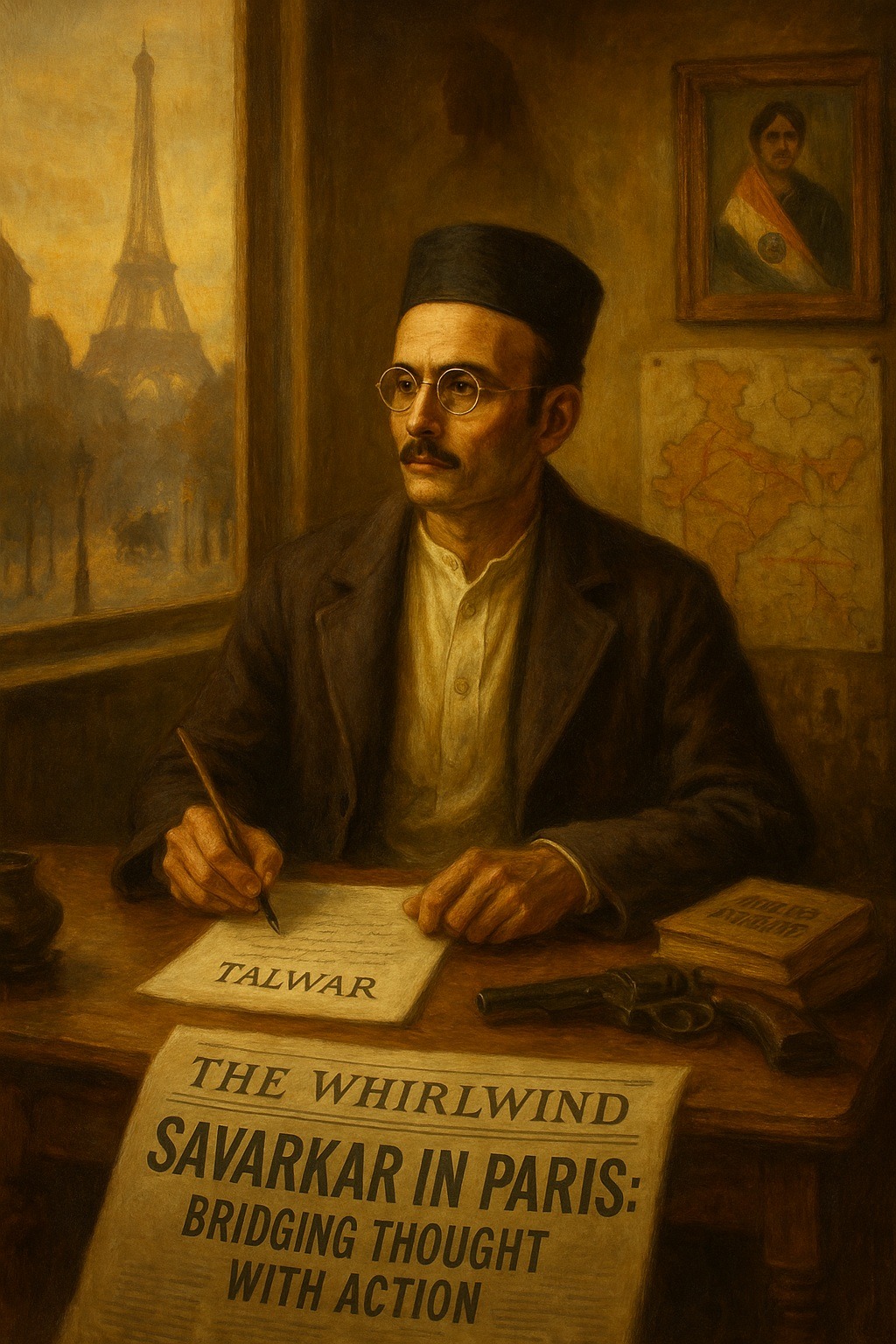Vinayak Damodar (Veer) Savarkar’s time in Paris (1909–1910) marked a decisive chapter in his revolutionary journey. It was a period of exile, reflection, and renewed determination, shaped by both personal hardship and the escalating storm of the Indian independence struggle.
A Period of Strain and Loss
The latter part of 1909 was fraught with turmoil for Savarkar. The relentless stress of leading revolutionary activities from London took a toll on his health, resulting in a severe fever and acute bronchitis. He was treated in a sanatorium in Wales under the care of Dr. C. Muthu, while Pandit Shyamji Krishnavarma and others supported him financially.
During this period, devastating news reached Savarkar: A.M.T. Jackson, the British Collector of Nashik, had been assassinated, and his younger brother Narayanrao Savarkar was arrested alongside many other young revolutionaries. They were charged with murder, conspiracy, and waging war against the British Crown. This blow weighed heavily on Savarkar, prompting his friends to urge him to leave London, where his life was in constant danger.
Arrival in Paris
In January 1910, Savarkar left London for Paris after a secret meeting of the Abhinava Bharat Society paid tribute to his “selfless work and noble patriotism.” Paris welcomed him with open arms. The Indian revolutionaries in Paris, led by Madame Bhikaji Cama, were eager to collaborate with Savarkar. Paris, already a hub for political exiles and radicals, offered more freedom compared to Britain. From here, the center of Indian revolutionary activity shifted from London to Paris.
Key Activities in Paris
Savarkar’s time in Paris was a whirlwind of planning, propaganda, and international networking.
1. Connections with International Revolutionaries
Savarkar met and exchanged ideas with European anarchists, including Russian and Irish revolutionaries. Their tactics—especially armed resistance—deeply influenced his own approach to the Indian freedom struggle.
2. Collaboration with Madame Cama and the Paris Indian Society
Madame Cama, already a towering figure among expatriate Indian nationalists, provided Savarkar both shelter and a platform. Together, they invigorated the Paris Indian Society, founded by S.R. Rana and Cama. Savarkar’s uncompromising call for complete independence, rather than moderate reforms, shaped the society’s ideological stance.
3. Publications and Propaganda
Savarkar worked tirelessly to finish “The Indian War of Independence, 1857,“ a groundbreaking historical account that framed the 1857 uprising as India’s first war for freedom. To bypass British censorship, the book was published in the Netherlands with the help of Paris-based revolutionaries.
Paris also became a printing hub for revolutionary pamphlets, which were smuggled into India to inspire resistance.
4. Training and Strategy
Savarkar formulated plans for sending arms and literature to India. He also mentored young revolutionaries arriving from India, preparing them for the challenges of underground activism.
The Shadow of Jackson’s Murder
The Nashik Conspiracy Case revealed Savarkar’s pivotal role as the spirit of India House and the guiding force behind the Abhinava Bharat Society. British officials, particularly George Clarke (later Lord Sydenham), saw Savarkar as “one of the most dangerous men that India had produced.” Dhananjay Keer’s points out that while Savarkar’s Paris comrades begged him to remain in safety—“As a general, you must remain behind to lead,” they said—he refused. “I cannot see the persecution of my colleagues and followers. As a leader, I must face the music,” he declared. He believed in preaching with his life, not just his lips. Determined to stand with his comrades, Savarkar decided to leave the relative safety of Paris and return to London, fully aware of the arrest warrant awaiting him.
Legacy of the time in Paris
Savarkar’s intermezzo in Paris was short yet profoundly influential. It was here that he:
- Internationalized the Indian independence struggle by connecting it with global anti-colonial and socialist movements.
- Consolidated the ideology of militant nationalism, laying the groundwork for a more organized revolutionary movement.
- Earned recognition as one of the most resolute and visionary leaders among Indian revolutionaries in Europe.
Final Thoughts
Savarkar’s time in Paris was a bridge between his intellectual work and direct revolutionary action. While London made him a strategist and organizer, Paris transformed him into a symbol of fearless commitment—a leader ready to risk everything for the cause of freedom.
💭 What do you think? How do you see Savarkar’s Paris years influencing his later strategies for India’s independence? Do you think his connections with European revolutionaries strengthened the Indian struggle, or risked isolating it from mainstream politics? Savarkar chose to leave the safety of Paris and return to London despite knowing he would be arrested. Do you see this as a mark of leadership or as a strategic mistake?
👉 Share your thoughts in the comments below!
Sources:
KEER, Dhananjay. 1988. Veer Savarkar. Third Edition. (Second Edition: 1966). Popular Prakashan: Bombay (Mumbai).
SAMPATH, Vikram. 2019. Savarkar (Part 1). Echoes from a forgotten past. 1883-1924. Penguin Random House India: Gurgaon.
SAVARKAR, Vinayak Damodar. 1993. Inside the enemy camp. Veer Savarkar Prakashan: Mumbai. SRIVASTAVA, Harindra. 1983. Five stormy years: Savarkar in London (1906-1911) – A centenary salute to V.D. Savarkar. Allied: New Delhi


Leave a Reply